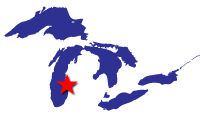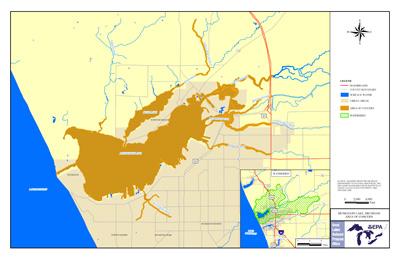Muskegon Lake AOC
Locate It
Contact Us
Contact: Mark Loomis
(loomis.mark@epa.gov)
312-886-0406
Latest News
- Musksegon Lake Habitat Management Plan Exit
- Zephyr remediation team wins Environmental Excellence Award
- Back from the Brink: A Muskegon Lake Film Exit
Overview
Muskegon Lake is a 4,149-acre drowned river mouth lake that flows into the eastern shore of Lake Michigan. The Muskegon Lake AOC includes Muskegon Lake, all of Ruddiman Creek, Ryerson Creek, Four Mile Creek, the north and south branches of the Muskegon River to their juncture with U.S. Highway 31, Bear Creek, Bear Lake and up through an unnamed tributary to Little Bear Creek.
Muskegon Lake was designated an AOC through the Great Lakes Water Quality Agreement in 1987 due to ecological problems caused by:
- Historical industrial discharges of pollutants into the AOC
- Shoreline development and hardening
- Historic sawmill debris, foundry sand and slag filling open water and coastal wetlands
- Localized groundwater contamination moving toward the lake and its tributaries
This resulted in:
- Sediment contaminated with petroleum hydrocarbons, mercury, lead, other heavy metals, oil, PAHs, and PCBs
- Excessive fill and loss of natural shorelines along Muskegon Lake and large-scale impacts to critical wetlands
- High levels of nutrients, solids, and toxics entering the lake
- Degradation of water quality
Muskegon Lake is now seeing the community benefits from restoration and remediation being conducted in the AOC. Recreational use of the rivers and Muskegon Lake by residents and visitors has increased, tourism is up, and property values have grown.
Beneficial Use Impairments
A good sign cleanup and restoration work is succeeding is the removal of beneficial use impairments. Beneficial use impairments are designations given by the International Joint Commission representing different types of significant environmental degradation. As cleanup work is completed, and monitoring demonstrates sufficient environmental health improvements, BUIs can gradually be removed. This AOC has removed four BUIs and has five more to eliminate. See the list below. Once all BUIs are removed, the process of delisting the AOC can begin.
- Beach closings - Removed 2015
- Restrictions on Fish and Wildlife Consumption – Removed 2013
- Eutrophication or Undesirable Algae
- Restrictions on Drinking Water Consumption, or Taste and Odor – Removed 2013
- Degradation of Fish and Wildlife Populations
- Degradation of Aesthetics
- Degradation of Benthos
- Restrictions on Dredging Activities - Removed 2011
- Loss of Fish and Wildlife Habitat
- General information about BUIs: Beneficial Use Impairments for the Great Lakes AOCs.
Remediation and Restoration Work
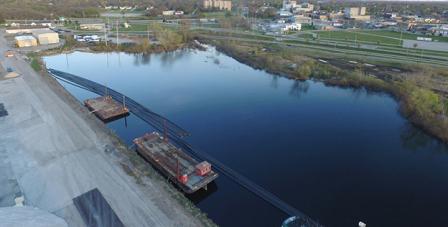 Ryerson Creek facing southeast from the Verplank Pier. The remediation work here has not yet started, and the project is in Feasibility Study/Remedial Design phase. Photo Credit: Bradly Benson, ORISE Research ParticipantTo delist the Muskegon Lake AOC, 11 management actions have been identified and are scheduled to be completed by 2020 or 2021. These management actions include sediment remediation projects to remove contaminants from the environment and habitat restoration projects aimed at restoring critical habitat, such as wetlands, necessary for local fish and wildlife populations.
Ryerson Creek facing southeast from the Verplank Pier. The remediation work here has not yet started, and the project is in Feasibility Study/Remedial Design phase. Photo Credit: Bradly Benson, ORISE Research ParticipantTo delist the Muskegon Lake AOC, 11 management actions have been identified and are scheduled to be completed by 2020 or 2021. These management actions include sediment remediation projects to remove contaminants from the environment and habitat restoration projects aimed at restoring critical habitat, such as wetlands, necessary for local fish and wildlife populations.
One last contaminated sediment project remains — Ryerson Creek Outfall which is located along the shoreline of Muskegon Lake. It is contaminated with petroleum, metals, and PAHs. There are several additional habitat projects to complete before the AOC can be considered “management actions complete.”
Once these projects are completed, and enough monitoring has demonstrated restored environmental function, BUIs can be removed, and the delisting process can begin. Not only will these projects enhance environmental productivity, but they will also add significant socioeconomic value to the surrounding communities.
- Documents on Restoring the Muskegon Lake AOC
- Remediation and Restoration Projects for Muskegon Lake AOC
Sediment Remediation Project Highlight: Zephyr Oil Refinery
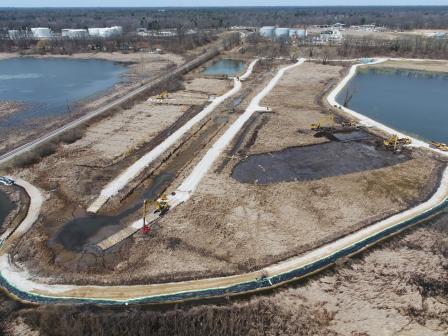 Contractors beginning excavation work in 2018 at the Zephyr Oil Refinery Site.Cleanup and habitat restoration work is complete at the Zephyr Oil Refinery site. The project remediated 49,000 cubic yards of sediment contaminated with petroleum hydrocarbons, lead, and other heavy metals. EPA partnered with the Michigan Department of Environment, Great Lakes, and Energy to remove the contaminated sediment and restore 15 acres of productive wetlands next to the North Branch of the Muskegon River. Wetlands restoration and contaminant removal have created a habitat suitable for a variety of native species such as frogs, turtles, and fish. This project was also a necessary step to remove the “Degradation of Benthos” BUI and eventually delist the AOC. The $15 million project made possible through the Great Lakes Legacy Act opens opportunities to the community for recreation, tourism, and possible economic redevelopment.
Contractors beginning excavation work in 2018 at the Zephyr Oil Refinery Site.Cleanup and habitat restoration work is complete at the Zephyr Oil Refinery site. The project remediated 49,000 cubic yards of sediment contaminated with petroleum hydrocarbons, lead, and other heavy metals. EPA partnered with the Michigan Department of Environment, Great Lakes, and Energy to remove the contaminated sediment and restore 15 acres of productive wetlands next to the North Branch of the Muskegon River. Wetlands restoration and contaminant removal have created a habitat suitable for a variety of native species such as frogs, turtles, and fish. This project was also a necessary step to remove the “Degradation of Benthos” BUI and eventually delist the AOC. The $15 million project made possible through the Great Lakes Legacy Act opens opportunities to the community for recreation, tourism, and possible economic redevelopment.
Restoration Project Highlight: Bear Creek Restoration Project
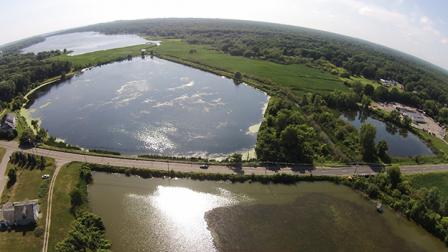 An aerial view looking northwest, showing Bear Creek wetland restoration. Photo Credit: West Michigan Shoreline Regional Development Commission.The Bear Creek restoration project restored 63.6 acres of wetlands, reestablished natural water flow for fish passage, repaired over 2,000 feet of stream bank, and improved water quality. Restoring wetlands at Bear Creek, a tributary to Bear Lake and Muskegon Lake, provided habitat for native fish, turtles, frogs, mammals, migrating birds, waterfowl, and other birds.
An aerial view looking northwest, showing Bear Creek wetland restoration. Photo Credit: West Michigan Shoreline Regional Development Commission.The Bear Creek restoration project restored 63.6 acres of wetlands, reestablished natural water flow for fish passage, repaired over 2,000 feet of stream bank, and improved water quality. Restoring wetlands at Bear Creek, a tributary to Bear Lake and Muskegon Lake, provided habitat for native fish, turtles, frogs, mammals, migrating birds, waterfowl, and other birds.
This project is unique in that 182,735 tons of sediment contaminated with harmful levels of phosphorus was removed from the area to address the “Eutrophication or Undesirable Algae” BUI. Elevated levels of nutrients such as phosphorus in a waterbody or its sediment can cause excessive plant and algal growth because it is a limiting growth factor needed for photosynthesis. This can be harmful to human health. Since the sediment was the source of phosphorus to the system, its removal successfully addressed eutrophication issues in the Muskegon Lake AOC. EPA, through GLRI funding, partnered with NOAA, the Great Lakes Commission, and the West Michigan Shoreline Regional Development Commission to complete this project in 2017.
Partners
The following links exit the site ExIT
- City of Muskegon
- Grand Valley State University
- Great Lakes Commission
- Illinois-Indiana Sea Grant
- Michigan Department of Community Health
- Michigan Department of Environment, Great Lakes and Energy
- West Michigan Shoreline Regional Development Commission
- Muskegon County
- Muskegon Charter Township
- Muskegon Lake Watershed Partnership

